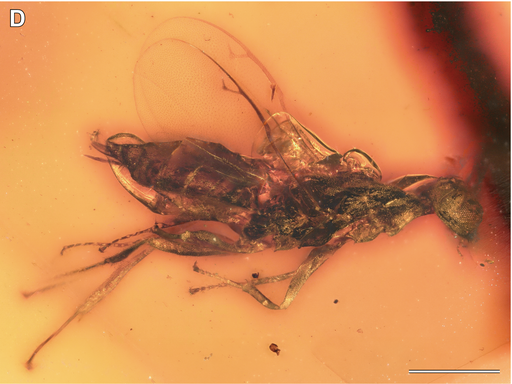Jewel wasps (Ampulex compressa) are among the most diverse and fascinating groups of insects of the family Ampulicidae. Also known as emerald cockroach wasps, they are solitary organisms adorned with dazzling colors and shapes.

These insects are known for being parasitoids because they lay their eggs inside the bodies of other insects, which will later become food for the developing larvae. How these wasps evolved to become diverse and specialized has baffled scientists for decades.
Based on fossils and molecular work, this immense group is thought to have originated around 162 million years ago. Until recently, no confirmed fossils were known of over 100 million years ago.
Oldest Known Family of Jewel Wasp
A team of scientists from Germany and Lebanon discovered a previously unknown family of jewel wasps in Cretaceous amber from Lebanon. The newly described family, Protoidae, provides the first clue into how these insects appeared at the earliest stages of their evolution.
The discovery came about when Dr. Lars Krogmann from the State Museum of Natural History Stuttgart (SMNS) noticed a strange fossil while visiting the Natural History Museum in Paris. The amber-encased wasp specimen had a long tail-like structure that covered its ovipositor.
This specimen had been listed as an entirely different species of wasp, but Krogmann and his colleagues soon realized that it was, in fact, an ancient chalcid. Despite the prevalence of Chalcidoidea in the fossil record, none had ever been found in Lebanon or were known to be as old as 130 million years.
Experts soon realized that they had a new and very old family, which is also the oldest known among the jewel wasps. It is also considered as the oldest known specimen in the world. The new family now contains two genera, Protoita and Cretaxenomerus, and ten new species of jewel wasps.
The ancient species feature some characteristics that are different from modern jewel wasps. These include a long, shovel-like process at the end of the abdomen, which may have helped them in laying eggs or in searching for hosts.
READ ALSO: Jewel Wasp Has Abilities To Turn Cockroaches Into Zombies
Evolutionary History of Jewel Wasps
The discovery of the Protoidae family offers valuable insights into the diversification and adaptation of jewel wasps to various ecological niches over time. By comparing these fossils with the currently living species, scientists can infer the order of evolutionary events and the origin of some bodily structures that led to the immense diversity we see today.
Experts also note that there are likely other equally old families of jewel wasps that still wait to be discovered, either in the ground or in museums. According to research co-author Jonah M. Ulmer, Protoitidae is evidence that we can keep looking further back in time than expected and still find new and old species of organisms.
Aside from their evolutionary history, jewel wasps are also fascinating for their ecological role and behavior. They are natural enemies of pests like flies, scale insects, and aphids. By studying both living and fossil jewel wasps, experts can learn more about these amazing insects as well as their impact on biodiversity and ecosystems.
RELATED ARTICLE: Cannibal Baby Wasps Eat Their Siblings When Food Is Running Low [REPORT]
Check out more news and information on Wasp in Science Times.














